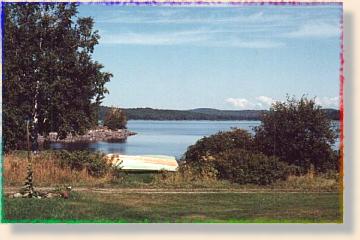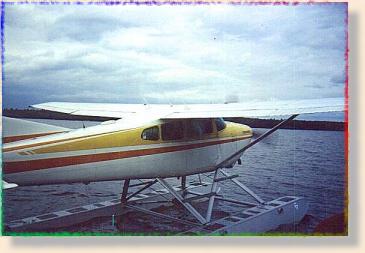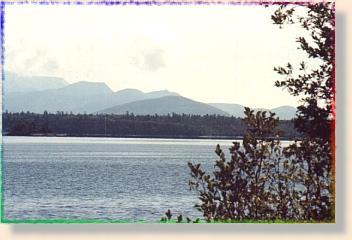The entire forest and watershed felt brilliantly alive. The air
was brisk, but not cold. The sky was a crystal blue color with
abundant sunshine. It was early September and the leaves were
changing colors. The plane made a steep bank after rounding a
place called the "ledges". We followed the riverbed for more
than ten miles dodging treetops; swooping and souring like a bird.
Heading northeast, the single engine Beaver made a wide sweep and
prepared for landing in a protected cove on the north end of Chesuncook
Lake. There are only three ways in: floatplane, 25 miles by boat,
or by half-track (takes nine hours).

Charlie seemed anxious. He seemed nervous when we boarded at Goose
Pond in Bangor. I sensed sadness in him as the taxi driver waved
goodbye driving away in a big cloud of dust. The floatplane stood
silent, except for the pilot holding a wing strut to help us with
our gear. One foot on the dock and the other on a pontoon. The
single engine Beaver looked more than capable to handle our gear.
She was beautiful. A bush plane called for some challenging flying.
The pilot flew her over from Folsom's Air Service in Dexter.
This Beaver was a testament to modern bush plane aviation, quick and
agile. But somehow Charlie couldn't stop thinking about the cushy
seats in the Delta First Class Cabin. This was roughing it. I think
it really threw him when the pilot referred to a USGS map to get his
bearings. "There's Big Spenser Mountain," he'd say, and "Look! A
moose and her calf down along the tree line." Charlie wouldn't look
out the window. He stared straight ahead at the back of the pilot's
seat. His hands gripped the seat so tightly I thought I could hear
the stitching let go.
The pilot pointed out the wave action. You could tell the direction
of the wind and pick the best approach. The landing would be short,
"tighten your seat belts, you might feel a bump." We started our
decent and in seconds we were on the water taxing to Burt's dock.
Burt and Maggie ran a B&B from a large farmhouse situated right
on the lake. With four year-round residents in Chesuncook
Plantation, they accommodated everyone who needed access to
the water.
Dave and Mike Maloney, and David Knight met us at the dock. It
was a good reunion with high-fives all around. We unloaded and
packed all the gear into the back of the Suzuki 4x4 for the trek
to the cabin. The weather was starting to turn windy and gray,
so we helped the pilot push off. These pilots ferry people in
and out of the remote wilderness areas in all kinds of weather.
I was sorry to see him leave. But, it was time to get settled
for some serious fly-fishing.

Late fall is the last time we could fly fish for landlocked salmon
before everything froze over. From our base we would canoe thirty
miles north, above Chesuncook. The upper end of the lake meets the
Penobscot River. To the northeast we'd pass Black Stream, Brandy
Pond and wind our way to the Logger Jam and spillway running due
east from Caucomgomoc Lake (about 16 miles east of the Canadian
border). That was our destination.
This is truly wild, wild country. It pays to be woods-savvy,
especially during the Moose Rut. Encountering wildlife is inevitable.
There are more bear and moose, than people. Being extra careful in
the backcountry is essential. The logger-jam and stream are prime
areas for fishing. They hold some of the biggest salmon and trout
I've ever caught. Once, Rick and Eddie caught 22 salmon in a 12-hour
period. They threw all but two back. The slot limit is 16-inches
with one allowed per person. Our rule is 20-inches or better, and
only three per day for four people. Don't catch more than you
need to eat. In a remote area you can only take so much gear
and supplies with you. Fresh salmon or trout cooked over an
open campfire is a real treat.
The aroma of coffee filled the air. I opened my eyes to see a
blurred dial on the clock. It pointed to 3 am. Rick was first
up and couldn't wait to fish. He looked annoyed as four groggy
people staggered and stammered to the kitchen table. Scrambled
eggs and bacon tasted great. We finished eating and were moving
up river by 4 am. One hour to Black Pond. Thirty minutes through
some rapids in the Black Stream connecting the opening to Brandy Pond.
The stream makes a wide turn and a small rise in elevation. Nearby
is a U.S. Forestry campsite. 400 yards ahead, the stream swings
to the right and back again, acutely to the left. You can't see
around the bend in the stream. So this part of the water is taken
slowly. There are huge ledges and boulders that create eddies
that can be tricky going up stream. Our utility boat strains
against the push of the river and the load in the canoes. But
we manage past Brandy to flat water edged by a large grassy meadow
where the current slows down. With the boat beached and secured
to a large pine tree, we readied the canoes for the trek up stream.
Waders and boots were put on. Usually that's not a good idea in
a canoe, but the water (48 degrees) is less than two feet deep.
It's better to get out with the waders than get wet. The stream's
slow current made paddling easy.
As we rounded a bend in the river we see six moose with calves and
a bull standing long the water's edge. Moose are so unpredictable
that they can chase you down in the river and trample you. They
just panic every once in awhile. You need to be cautious. Slowly
we paddled up stream past the grazing moose. They never even looked up,
just continued eating. We made our way to a spot about two miles
below the spillway. The canoes were pulled up the bank and over
to an old campsite. We all sat down, had a snack and took off our
waders. When we were ready to move on, we slung the waders over
our shoulders with our boots hanging from their laces.
We'd get the canoes in two days, after working our way down stream
from the spillway. The 3-mile hike took us through thick saplings
and up a trail marked by coyotes, fox, rabbit, dear, and moose tracks.
You could tell this was the rut from the number of moose droppings
and tracks. Once in awhile you'd hear wild snorting coming from
somewhere deep in the woods. Backpacks, rods and shoes clanged with
each step as we made our way to a clearing. Going was pretty easy.
Just below the spillway, the old camp was a welcome site. We had
camped there every spring and fall for more than fifteen years.
Judging by its appearance, the last visitors left it in great shape.
We took another breather, unpacked, set up the tents, and set out to
gather wood for a campfire. We stored all our provisions in the
tents and made preparations for fishing the stream. Our waders and
boots were put back on. Rods were assembled and line and tippets
secured. Flies of choice in late fall would be marabou muddler,
gray ghost, black or olive wooly buggers. It was 6:30 am before
we stepped into the stream below the spillway.
We fished the spillway working our way down to the logger-jam. The
stream widens into a large pool. This area holds a lot of fish
because the water is still ripping through, as it falls about ten
feet in elevation. A stretch of small rapids follows the logger-jam.
Even though the water is very shallow, it holds the biggest fish.
Fly-casting is easy. Just put your line out and let the current
take it. You can easily position the fly. Salmon will hide behind
boulders, facing upstream waiting for a weary fish to drift near
them. The first salmon catch that's a keeper is cleaned right
in the river. It helps to find out what the salmon are eating
so we can select the right fly. In the fall salmon usually
gorge themselves on big leaches, grubs and pilchards. They forage
off the bottom just like redfish do with crabs and shrimp.
Dave worked his way down past the logger-jam and past the next
set of rapids. We were working our way down stream. Rick and
Charlie scored on 2 monsters, five pounds each. Then Dave and
Mike landed a couple of small salmon which were quickly released.
I was working on a hookup when I saw Rick do a cartwheel on a
boulder. He was holding his rod straight up and I could see
him moving quickly down stream. I'm sure water poured down
his waders, but that didn't seem to phase him. In about three
minutes he had moved past Mike and was on his way about a 50
yards from me. You could see his rod bending under the pressure
of the fish and the rapids. It had to be a big fish, because it
was pulling him down stream. He was so into the 'zone,' I don't
think he realized what was happening. He just went with the flow
and worked that fish downstream, around boulders, in and out of
eddies, around a steep ledge. He followed the salmon downstream
about two hundred yards.
Rick kept moving with the fish, dancing, skipping and jiving with
the water and rocks, always staying vertical and keeping that rod
tip high. Finally he stopped as the stream settled out. He landed
the biggest salmon I've ever seen, but we didn't have a camera.
Seven pounds, 26 inches on 6-pound tippet. I'm sure it was a
world record landlocked salmon, but there was no way for us to
record it. Rick had already cleaned his first fish and this
one was released. The salmon was beautiful with pink/purple
along the dorsal, iridescent spots along the back and above
the gill plate. The rest was a silver/green/gray with dark
green fins. What a really beautiful fish. This action can
really make you spellbound. We fished some more and caught
a little over 20 salmon. Dave and Mike both caught a couple
of native trout. Each one was about 14 inches. That night
we had a wonderful feast on salmon, but saved the trout for
breakfast. The next day brought more spectacular fishing.
We finished fishing by noon and made our preparations for the
trek back to the canoes. Even with loaded backpacks we fished
the edges of the stream. We were all pretty exhausted by the
time we reached the canoes. The stream was teeming with fish
and it was great fun.
By the time we returned to the boat, it was 2 p.m. Paddling with
the current was effortless. We fished all the way to the head of
Brandy Pond. Then loaded the boat and pushed off down stream.
The last run was over for us. We were tired and pretty much fished
out. We motored through Black Stream and down to Chesuncook.
Into a bright sunny day, we were recharged by being in such a
wonderful place.

The rut was in full swing and you could hear moose snorting and
blowing. Unmistakable crashing of antlers signaled young bulls
challenging adults. New relationships were being formed with
the activities to bring new life in the springtime. You could
also hear what sounded like a freight train, fast stomping and
loud rubbing - just moose preparing for their last run before winter.
~ Doug
About Doug:
Capt. Doug Sinclair has relocated from New Smyrna Beach, Florida to
Grantsboro, NC. He specializes in fly-fishing and light tackle charters.
Doug charters the Coastal Carolina area of New Bern or Oriental.
Catch him on the web at
www.flyfishacademy.net or call him at (252) 745-3500.
Doug is also a Sponsor here on FAOL.
|









